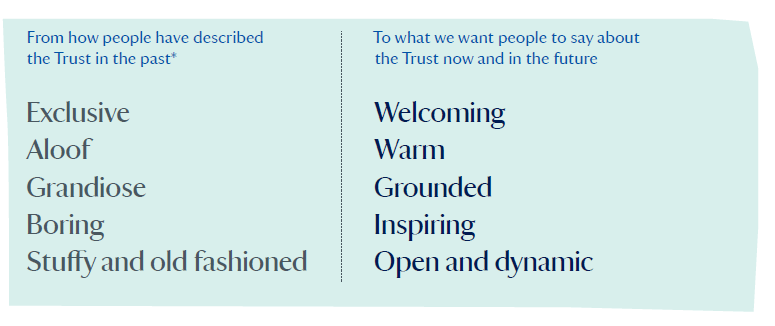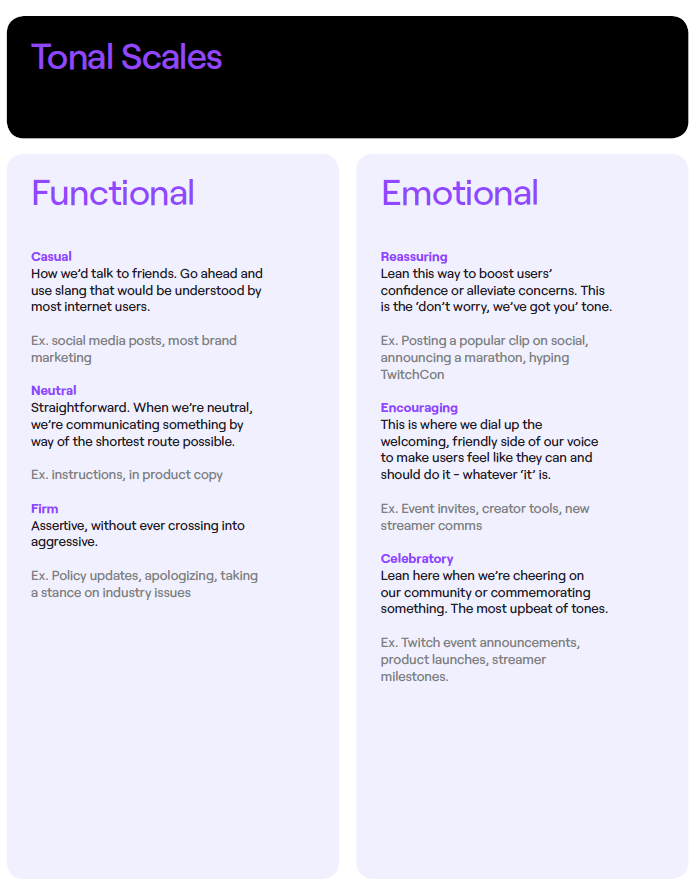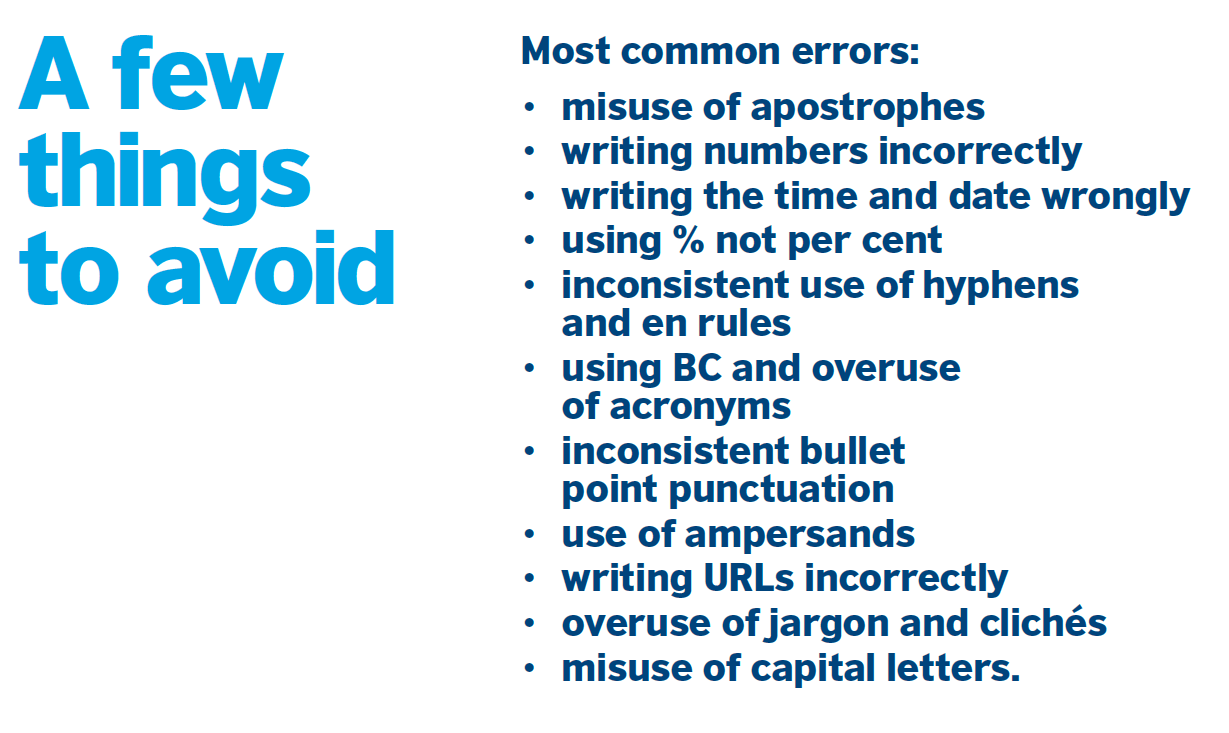What you should find in your tone of voice guide
Maybe you already have a set of tone of voice guidelines for your business, or perhaps you’re looking to develop your first and you’re wondering what they should contain.
The truth is, each guideline should be slightly different depending on your organisation, your goals, the size and strengths of your team, and what came before. This blog post is an introduction to the most important elements of tone of voice guidelines, as well as some optional extras and why they might be useful.
Remember, the whole point of a tone of voice guide is that it’s like a recipe: the reader should be able to read it and fairly faithfully recreate the brand voice with minimal back and forth. It can help to start with a piece of copy that feels 100% on brand and work backwards asking, “What went into this copy to make it work?”
For each section, I’ve shared examples from real-life guidelines to give you an idea how they look in the wild.
Essential
I’ve split my list down into what I consider to be the essentials as well as the ‘nice to haves’. Let’s have a look.
The intro
First, your guidelines should have an introduction. Here, you want to learn the essentials of the tone of voice, where it’s come from and how it ties back with the rest of the business – your values, customers and goals.
This example from Mailchimp is best in class because it’s short, but it really packs a punch. In just a few words, it explains who the brand is and why it behaves the way it does with reference to the industry and the brand’s position within it.
Mailchimp’s tone of voice guidelines have a short but compelling introduction
The personality pillars
Sometimes called principles or traits, these are the (usually) three to four identifying words that you want your brand to be known for. The words you want your customers to say about you when you’re not in the room. Each should be explained and linked back to brand behaviours and brand values.
In the National Trust’s 2014 brand voice guidelines, they use a couple of words for each pillar.
The National Trust’s 2014 tone of voice guide had four personality pillars
Some brands also like to talk about what they’re not. This can be helpful to reinforce the personality pillars and ring-fence nuances that can’t be explained in a single word. For example, a brand that might be exclusive but never stuck up. Sweet-natured but never cutesy.
Another time this is helpful is if your brand is making a break from the past. Going back to the National Trust, they wanted to shake off their image of being exclusive, aloof, grandiose etc. So they set this out in very clear terms in their guidelines.
The National Trust explains what it’s not
The writing guide
For each personality pillar, you should have a set of writing tips and tricks that bring that trait to life. It’s about giving the person reading the guidelines enough of a steer on how to get that principle across in writing. It’s best if these are accompanied by example copy to illustrate the point.
ClassPass, appropriately for a fitness brand, uses active verbs to describe their personality pillars. Below the short description, you’ll find four writing tips to help bring that pillar to life in writing.
ClassPass
Notes on tone
If voice is who we are all the time, tone is how we flex for different scenarios. Your tone of voice guidelines should contain notes on tone if, for example, your brand sounds different on Instagram than it does in your T&Cs. Or perhaps your target audience includes a range of different personas who each need addressing in a slightly different manner, for example, a school whose copy will be read by both parents and students. Another way in which you may want to flex tone is across the buyer journey. For example, an aesthetician may adapt tone when they’re promoting their services compared to when they’re giving aftercare instructions.
Note that these should be minor tonal adjustments that still feel on-brand for the overarching tone of voice, otherwise you’re not creating a cohesive brand.
It’s worth listing out the different scenarios, audiences or stages in the customer journey that might elicit a shift in tone for your brand. Have they all been accounted for in your guidelines?
I love this tonal scale from Twitch that sets out how and why you might adapt your tone of voice and gives examples of specific circumstances for each.
Twitch takes on tone in their brand voice guidelines
A checklist
If your guidelines are longer than the Bible, it’s unlikely anyone will ever pick them up and use them regularly. A checklist is a useful tool for both your writing and editing team to assess a piece of copy against the guidelines without having to pull an all-nighter at the office.
The British Council leans heavily on convenience, naming their guide ‘Your ten-minute guide’. They wrap up the verbal identity section of the guide with a checklist of common mistakes. This is a handy reminder for writers and editors to keep their copy consistent.
The British Council’s checklist of common errors to avoid
Practical examples
It’s only through seeing practical examples that your guidelines will come to life. The best way to do this is by sharing before/after to demonstrate the journey the copy needs to take to become on-brand. Ideally, there should be at least two examples, and they should replicate copy from different areas of the business and represent different tones within the wider brand voice. For example, a piece of web copy and an Instagram post. Or a marketing email, packaging copy and a press release.
Though it doesn’t go quite far enough (in my opinion), Bolt has example copy for its different target audiences split by principle.
Copy examples from Bolt
Nice to have
You’ve seen the non-negotiables. What follows are some bits that are good to have depending on the context but aren’t necessary for every guide.
Word choice
For some brands, this is about taking care over the words they use around sensitive topics. An organisation that works with survivors of violence might not like to use the word ‘victim’. For sustainable brands, choosing the wrong words could land you in trouble with the law thanks to the Green Claims Code. For others, it’s about owning a brand language, for example, the way Apple calls their store staff Geniuses.
In this example, Girlguiding makes it clear they want to refer to their part-time team as unit helpers, not occasional helpers.
Guidelines from Girlguiding
Writing tips
I’m a firm believer that tone of voice is not about teaching Mike from Finance how to write copy. Tone of voice guides are not writing guides. That said, if your organisation has an area of writing that is a problem consistently (maybe it’s how to use quotation marks or capital letters), there’s no reason why part of your tone of voice guide shouldn’t be writing support. Rule one of all writing is to deliver clarity. So if it feels appropriate, include a few short tips to support your writing or marketing team in achieving that. Let’s say readability is an issue, your guidelines might contain tips for reducing sentence length, simplifying language and writing more clearly.
The University of Leeds tackles clarity in these useful writing tips.
Writing tips from the University of Leeds’ tone of voice guidelines
Style guide
Technically, this is a separate piece of work to your tone of voice guidelines, but many have a style guide tagged on the end. The job of a style guide is to set out your brand’s rules when it comes to language and formatting for consistency and professionalism every time. It might explain how the brand uses capital letters or where abbreviations are allowed.
Here, Moodle covers key elements of style including regional spelling and date format. They also discuss the kind of language that is and isn’t acceptable.
Style and language guidance from the Moodle tone of voice guidelines
A list of useful tools
I always recommend tools that will help my clients’ teams achieve flawless copy faster. Things like Grammarly and Hemingway App, carefully selected according to their specific needs.
If you’d like to chat more about tone of voice guides and writing for your business, I’d love to hear from you.
















Maybe you’re considering tone of voice for your organisation. Or perhaps you work in marketing and use tone of voice guides on the regular. This one’s for you.
Your ultimate guide to how to get the most out of a tone of voice guide and hit the copy bullseye first time.